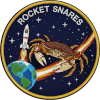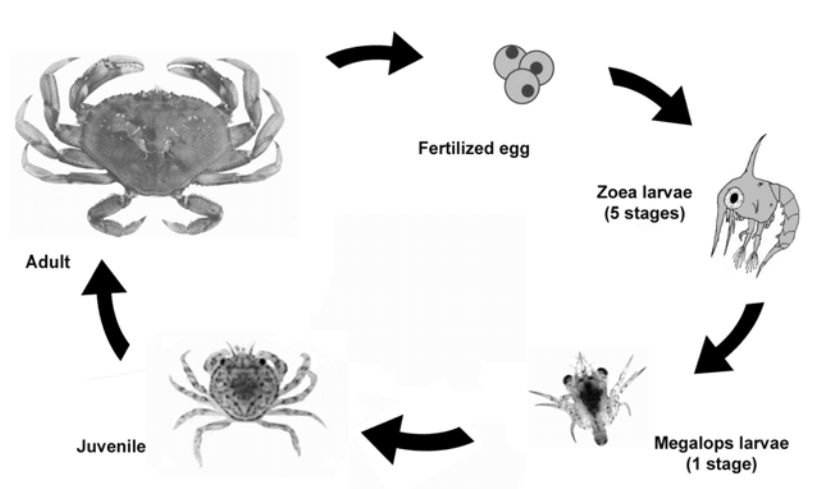There is circumstantial evidence that Dungeness crabs are attracted to light:
- Our crab snares glow in the dark with a sky blue color matching the peak visual spectral sensitivity of crustaceans and other marine species.
- Light traps are used to catch and monitor Dungeness crab megalops larvae.
- Artificial lights increase the catch efficiency of other crab species.
Color Vision in the Ocean
The figure below shows how deep different colors of light penetrate the ocean. Water scatters short wavelength light (ultraviolet) and absorbs long wavelength light (red). Blue and green light (~500 nm wavelength) travel farther due to water’s light absorption spectrum.
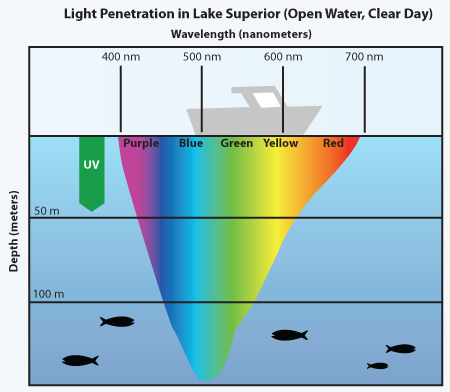
Given the physics of light in water, marine species have evolved eyes that are sensitive to blue/green light around 500 nm wavelength.
Our crab snares are 3D printed with glow-in-the-dark filament. The phosphorescent glowing effect is created by strontium aluminate, which is doped with rare earth elements to adjust the phosphorescent color. Although our filament’s exact formulation isn’t listed, eyeballing the glow color leads us to believe it’s CaSr4Al16O29:Eu+2,Dy+3,La+3. This formulation has an emission wavelength of 480nm, close to the color of peak visual sensitivity and maximum ocean penetration depth.
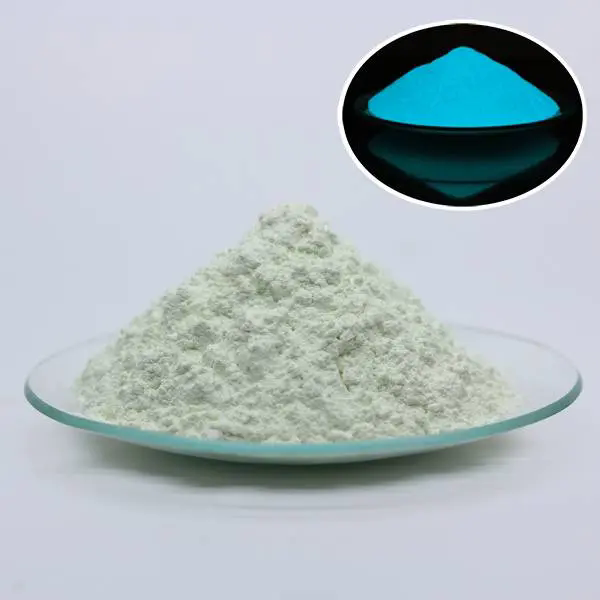
Dungeness Crab Larvae are Attracted to Light
The Dungeness crab lifecycle is illustrated below. Dungeness crab larvae are caught using light traps to monitor population dynamics.
Other Crab Species are Attracted to Light
We did not find research on the use of light to catch adult Dungeness crabs, but we did find research on the use of light to catch other crab species.
Blue Swimming Crab (Portunus pelagicus)
The effect of light on blue swimming crab behavior was first tested in the lab and then tested in the field. In the lab, the blue swimming crab was attracted to blue LED light more than other colors.
Our results suggest that blue swimming crab has a high preference for blue LED light. The frequency of crab moving toward attractant was highest with blue light, followed by natural bait, red light, and green light.
Based on the lab results, blue LEDs were advanced to field trials where they nominally increased the catch of Portunus pelagicus (and other crab bycatch like Charybdis anisodon). The increases were not statistically significantly different, but that is likely due to small sample size.
In conclusion, LED lights do not affect the catch, however, adding LED lights to the bait can increase the number of species caught, the number of individuals, the weight of the catch, and the effectiveness of catching kingfish (P. pelagicus).
Orange Mud Crab (Scylla olivacea)
Lab experiments on orange mud crabs tested their behavioral response to blue, white, green, and red LED light.

In captivity, green LEDs elicited the strongest behavioral response. Blue LEDs were a close second. Note, the peak wavelength for their blue LED light is lower than the peak visual sensitivity wavelength rage for marine species, so it would be worthwhile to optimize the blue LED wavelength for future experiments.
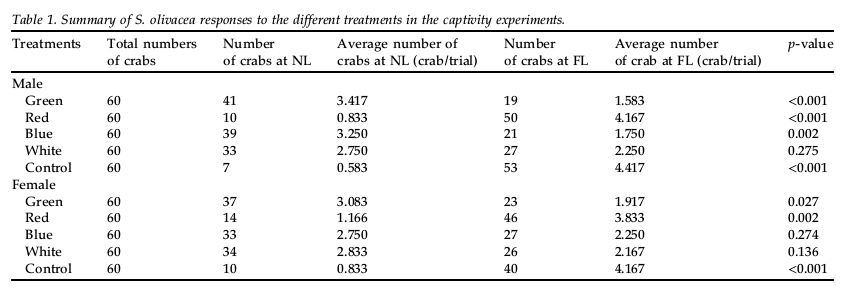
In field trials, a green LED alone was sufficient to catch orange mud crabs, albeit at a much lower rate compared to natural bait. It would have been nice to see if adding a green LED to natural bait increased catch rates, but that is left to future research.
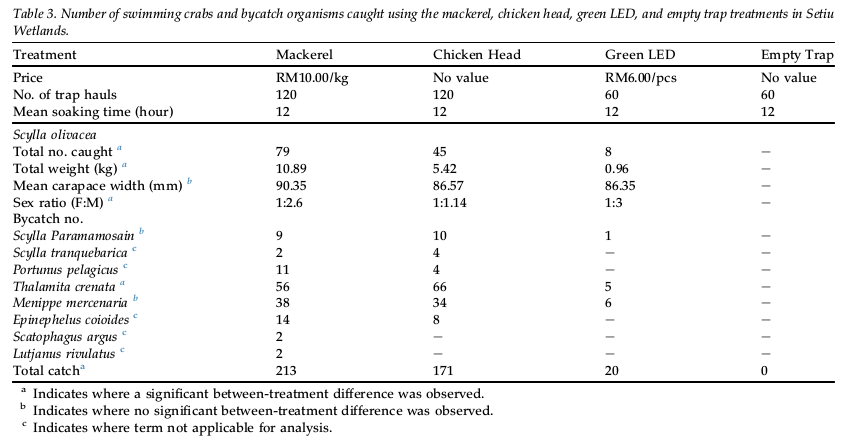
Snow Crab (Chionoecetes opilio)
Nguyen’s PhD thesis “Lighten Up: Using Artificial Light to Improve the Capture Efficiency of Fishing Gears” compiles many of their papers on snow crabs in one place.
LED lights increased the catch rate of snow crabs:
We created a novel choice-experiment in a laboratory setting in which we investigated the behaviour of snow crab in response to coloured LED lights. The results showed that snow crab movement was dependent on light colour, with animals choosing to move toward blue and white lights, away from purple lights, and no detectable effect for green and red lights. We then conducted two field experiments to investigate the effect of the same LED lights on the catch rates of commercial traps during the 2016 snow crab fishery on the east coast of Newfoundland and Labrador. Results from the first field experiment showed that adding white and purple LED lights into baited traps significantly improved Catch Per Unit Effort (CPUE) by 77% and 47% respectively. Results from the second field experiment showed that unbaited traps equipped with only LED lights (no bait), could also catch snow crab in comparable amounts to traditional baited traps, with soak time and depth explaining some of the variation in CPUE.
More interesting is their use of glow-in-the-dark crab pot netting, similar to our glow-in-the-dark crab snares. Crab pots with green phosphorescent netting resulted in higher snow crab catch rates.
A fishing experiment was subsequently conducted in eastern Canada to compare the catch rate of traditional and luminescent traps, and to determine how soak time affected catch rate. Results indicate that the effect of luminescent traps on the CPUE (measured as number of crab per trap) depended on the soak time. The CPUE was significantly higher (a 55% increase) in luminescent traps that underwent relatively short soak times (~1 d), but when soak times were longer (~8 d), the CPUE was not significantly different.
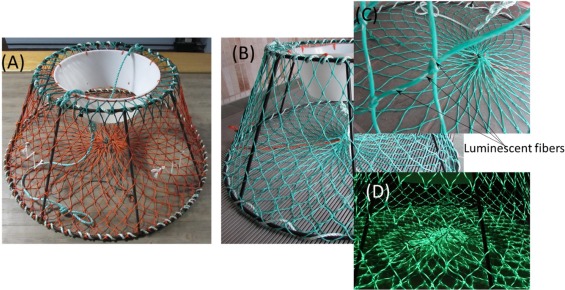
Our results showed that luminescent pots had a 21.6 % and 18.3 % higher catch-per-unit-effort (CPUE; number of crabs per pot) of legal-sized crab and sub-legal sized crab, respectively, than control pots; with no difference for soft-shelled crab.
Although Nguyen reported higher snow crab catch rates with luminescent traps, results were mixed in another study.
There were mixed results among treatments, with the 2-strand pot catching fewer snow crab <103 mm carapace width (CW) and more snow crab ≥103 mm CW than the traditional pots, but overall, had a lower CPUE for legal and sub-legal sized males (14.8 and 3.1 per pot, respectively) than the traditional (16.1 and 5.5 per pot, respectively) when considering all size classes.
Deep-Sea Crustaceans (500-1000m)
Another intriguing hypothesis is that deep-sea crustaceans’ vision evolved to help them catch and eat bioluminescent plankton that produce blue light.
This shift to blue sensitivity is an adaptation to both downwelling light, which becomes more monochromatic and blue with increasing depth (Jerlov, 1976), and bioluminescence, the vast majority of which lies between 450 and 510 nm (Herring, 1983; Widder et al., 1983; Haddock and Case, 1999).
Although there are clearly other possibilities to explain the relationship between the crabs and stationary benthic structures that project up into the water column, one intriguing possibility is that these crabs may be using their putative dual visual pigment systems to distinguish the green benthic bioluminescence of their preferred substrate, which they apparently do not eat, from the blue bioluminescence of the planktonic organisms impacting these structures, which may be their preferred food source.
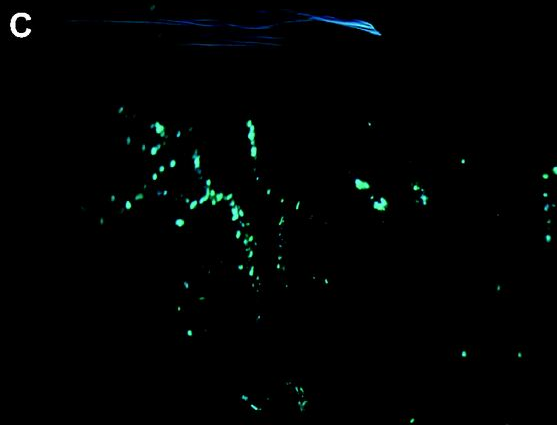
You don’t have to go to the bottom of the ocean to see bioluminescent plankton – you can see it from shore!
Conclusion
Light traps catch Dungeness crab larvae. Adding lights to traps increases the catch efficiency of other crab species. Maximal light penetration depth in the ocean, peak visual spectral sensitivity of marine species, and bioluminescence chemistry all converge on a blue wavelength. Therefore, we think our crab snares that glow in the dark with a sky blue color should help improve Dungeness crab catch rates.
